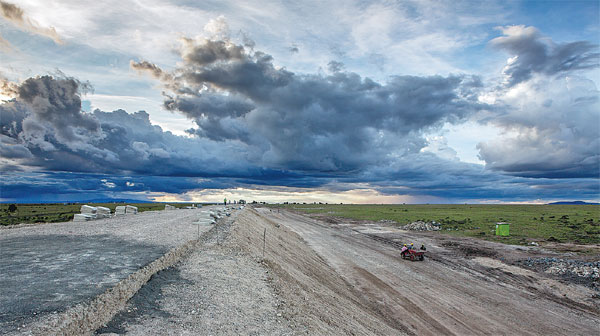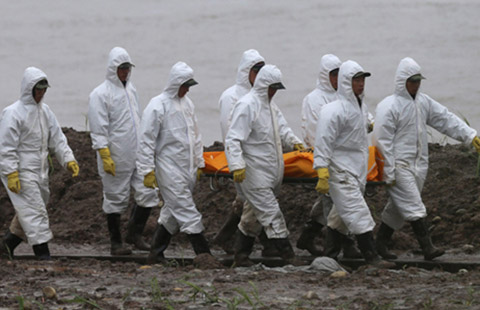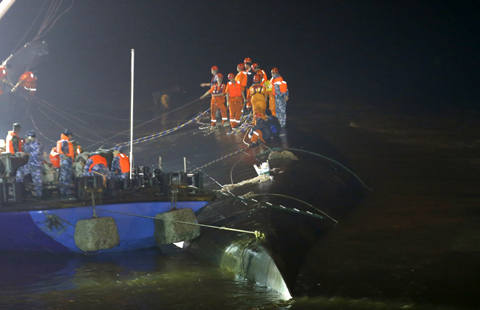
An overnight train ride from Nairobi to the seaside city of Mombasa can easily turn into a nightmare. It is not unusual for passengers to wake up in the morning stuck on the outskirts of the Kenyan capital. The train, which runs every two days, is supposed to leave Nairobi at 9 pm, but often does not depart until after midnight, and a journey that should take 15 hours can stretch to more than 20 hours.
Though slow and inefficient, the narrow-gauge railway, built by the British 110 years ago, has been a lifeline for Kenya and other East African countries, transporting passengers and goods between the two most important cities in the country. The alternative is a highway linking the two cities, but that can be just as difficult, given that it is often heavily congested.
Only a stone's throw from the old line, work is in full swing on a new railway line, using Chinese standards and technology, that will shorten the Nairobi-Mombasa trip to four and a half hours and will bring Kenya into the 21st century.

|
Top: A section of earth bed is built for the construction of the Mombasa-Nairobi Standard Gauge Railway. Above: Workers lay tracks for the construction of the Mombasa-Nairobi Standard Gauge Railway. Photos by Xie Songxin / China Daily |

Construction of the 472-kilometer standard-gauge railway, financed by Exim Bank of China, began in October and is expected to open in 2017. The estimated cost is $3.8 billion.
The Chinese infrastructure engineering and construction company China Road and Bridge Corp is employing about 1,900 Chinese and more than 10,000 Kenyan engineers and skilled workers on the project. The company says it will eventually employ 2,500 Chinese engineers and 30,000 local workers.
The Kenyan government estimates that construction of the standard-gauge railway will help the country generate 1.5 percent of its GDP and eventually enable Kenya to become a gateway of East Africa after the Mombasa-Nairobi section joins other sections being built or to be built in the region.
Chen Yun, head of the project and vice-president of China Communications Construction Co Ltd, the holding company of CRBC, says: "The opening of the railway, like the wings of a bird, will prepare East Africa and even the whole of Africa for economic takeoff.
"Once the line is open it will greatly change people's work and lives generally."
The new Mombasa-Nairobi line will play a leading role in the East Africa railway network, which will link Kenya, Rwanda, South Sudan and Uganda, and its value will become clearer when the East Africa railway network is completed and forms a large logistics circle in the region.
A more immediate effect will be a cut in transport costs.
Shipping a 6-meter container about 13,000 km from China to Mombasa costs about $1,700. Shipping it the extra 500 km or so to Nairobi can add about $1,000 to that.
The single-gauge railway is expected to reduce rail transport costs from $20 cents to 8 cents per metric ton per kilometer. It will also relieve the pressure on traffic on the highway, notable for the discarded oil containers due to accidents, and reduce the great damage from the trucks to the road.
"You see the challenge of the trucks (on Mombasa Road)," says Atanas Maina, managing director of Kenya Railways Corp.
The damage to the road is significant. The pollution is pervasive. With the single-gauge railway, one train, which can carry up to 200 containers, can get about 100 trucks off the road."
"One single train will be able to transport up to 1,000 people in four hours from Mombasa to Nairobi. There will be a big, big change. We will be able to move our people between the corridors very, very fast," Maina says
Even during the construction, changes have taken place along the line with increased business activity. Maina says people who were compensated in land acquisition now have the money to "undertake a lot more economic activities".
"In the entire corridor between Mombasa and Nairobi you will find a lot of businesses have come up."
Experts say the increased mobility that the railway gives will attract more investors in manufacturing, which will not only satisfy the increasing need from Kenya and East Africa's growing middle class, but also help reduce the trade deficit that has troubled countries in East Africa by facilitating exports.
In addition, many Kenyans and people in inland countries in East Africa who rely on imports will enjoy cheaper commodities as the cost of transport falls.
Chris Kirubi, a Kenyan industrialist, describes the project as the lifeblood of the region's economy.
"There is no country in the world that has developed without a bankable railway," the Kenyan newspaper Daily Nation quoted him as saying.
"It will not only boost export-import trade but link the country's 47 counties."
The construction project has already given a fillip to industries in Kenya and helped them update their technology and standards.
"The project will purchase a lot of materials locally, and this will help modernize and standardize quality since single-gauge rail standards are specific to technology," says Kevit Desai, of Private Sector Railway's Consortium, a group that advocates structured private sector involvement in the rail project.
CRBC has called for bids for 5,250 tons of steel bars, which are estimated to be worth 330 million Kenyan shillings ($3.7 million) from Kenyan manufacturers, and says it expects to buy more steel bars locally as the project proceeds. It has also been buying cement locally after helping local cement makers improve their formula to meet the standard of the project.
CRBC says it has bought materials worth $220 million from 225 local suppliers and worked with nine local subcontractors. It is negotiating with another 22 companies. The company says it will buy locally at least 40 percent of the materials needed.
"For the materials, machinery and services needed in the project, we will not buy from the international market as long as they are available in Kenya," says Li Juguang, a spokesman for CRBC.
"We will involve local partners in the project as much as possible to drive the development of related industry in the country."
The project will give a further boost to local manufacturing and make companies more price competitive after its completion.
Desai says: "Standard-gauge rail will increase mobility, reduce road congestion, remove major inefficiencies in the movement of both people and goods, and reduce the costs of doing business, which will in turn lead to the development of a competitive private sector platform, key to championing local, regional and global investment in Kenya and increased wealth creation for the people of Kenya.
"Transport plays a key role in manufacturing. With improved efficiency in mobility, manufacturers will be able to produce goods at a lesser cost, and in effect the cost of products will go down, making Kenyan goods more competitive in the region and beyond.
"This new and faster connection will enable new economic opportunities, create business in East Africa and make its markets integrated and more accessible for Kenyan business and the public alike."
Maina says the country has been planning to harvest long-term benefits the project is going to bring to manufacturing.
"There is a lot of planning going on to create this corridor (from Mombasa to Nairobi) as an industrial corridor. We are planning special economic zones and encouraging investors to come in to do business there.
"They don't need to engage in buying expensive land in Nairobi. They can operate from the whole corridor, manufacturing the goods and exporting outward from Port Mombasa, or inwards to other cities in inland countries in East Africa."
In the short term, the project creates employment in the country, which has been plagued by high unemployment. In the long term, the extensive involvement of Kenyans in the project will help establish a skilled labor pool that could greatly contribute to the construction of other infrastructure projects in Kenya and its neighbors, building a more solid foundation for economic growth.
More than 10,000 Kenyans are working on the project now, and up to 30,000 are expected to be employed before it is completed.
"We have about 1,900 Chinese experts working with them," Maina says.
"They are all engaged in the process of capacity building for locals. There is a lot of capacity building at technical and professional levels. Our engineers are working with the engineers of our contractor and engineers from the consultant SDI. And there is a lot of skills transfer going on.
"When we have Kenyans learning from Chinese experts we will be able to participate more in the construction of phase two (from Nairobi to Uganda). We also hope we can work with the rest of the countries on the northern corridor, Rwanda, Uganda and South Sudan, to provide skills from Kenya. It's important to create that balance.
"Under this phase we have agreed with the countries that they will bring in their engineers and (be given guidance on the) projects by Chinese experts."
Shen Yushan, assistant general manager of the project, says in a skills contest in one section of the project that the company will do all it can to make half of its local employees on the project senior skilled workers after the company finishes the railway.
The company has trained about 1,000 of the 5,000 Kenyan workers it plans to train for railway construction and management, including roadbed construction engineers and culvert construction engineers.
Li Juguang, the spokesman, says the company, with Kenya Railways Corp and the project supervisor, will make a comprehensive guide of standard-gauge railway construction technology and management for Kenya to facilitate future projects in the country.
The project will greatly benefit China as well. While promoting China's technical standards, with a lot of equipment bought from China, it helps relieve the market in China that has been troubled by excess production capacity.
"The project is the first part of the East Africa railway network," says Kou Xiaojun, executive deputy general manager of the project's Section No 7.
"The use of Chinese technical standards means that they will also be used in later sections."
The project has benefited many Chinese companies because a lot of machinery and equipment used in the project was bought from China, including trucks, excavators, and loaders, Kou says.
Contact the writers through houliqiang@chinadaily.com.cn
|
Clockwise from top: Workers prefabricate T beam cross sections for the construction of the Mombasa-Nairobi Standard Gauge Railway. A worker loads sand at the construction site in Mombasa. Pillars built for a super-bridge near the town of Kiu for the construction of the railway. Photos by Xie Songxin / China Daily |
(China Daily Africa Weekly 06/05/2015 page6)








